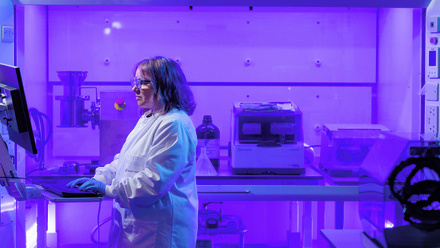mRNA Revolution: CPI case study

CPI is a social enterprise that catalyses’ adoption of advanced technology and manufacturing solutions for healthcare and sustainability innovations. In this case study, the BIA's report mRNA Revolution: A new generation of medicine explores CPI’s offerings within pharmaceuticals, including its facilities and expertise, drug delivery systems like lipid nanoparticles, world-leading expertise in the development of mRNA vaccines and Imperial College London to support the drive to develop, scale up, manufacture and supply vaccine candidates.

What does the company do?
CPI is a technology innovation catalyst. They catalyse the adoption of advanced technologies and manufacturing solutions that benefit people, places and planet. CPI is a social enterprise, partnering with industry, academia, government and the investment community to deliver healthcare and sustainability innovations.
Within pharmaceuticals, CPI offer world-leading facilities and expertise in small molecules, biologics, oligonucleotides, and complex medicines to accelerate drug development and scale-up. They host the largest pool of RNA biomanufacturing experts in the UK and offer complementary drug delivery systems like lipid nanoparticles.
CPI supported the UK Vaccines Task Force’s COVID-19 response with their world-leading expertise in the development of mRNA vaccines, working with partners such as Imperial College London to support the drive to develop, scale up, manufacture and supply vaccine candidates.
As part of this, CPI developed and built a new facility, The RNA Centre of Excellence, next to their National Biologics Manufacturing Centre in Darlington. This was designed to be a key part of the ongoing battle against COVID-19, a place where they could develop multiple vaccine candidates, ready to be rapidly manufactured in response to new variants.
What were the challenges you were seeing for RNA therapeutic manufacturers and how are you helping to address some of these?
Access to mRNA-LNP R&D and GMP manufacturing expertise with the people and facilities in a single location to support early-stage product development is a challenge for SMEs and academics developing breakthrough medicines in this space.
Post-pandemic, as life starts to return to normal, CPI now has a multi-million-pound facility, one of the largest pools of RNA knowledge in the UK, and the equipment needed to deliver this new technology.
Now known as the RNA Centre of Excellence, we have a facility that forms the backbone of the UK’s innovation infrastructure in RNA vaccines and therapies. This is the only open-access UK-based centre currently able to develop and manufacture lipid nanoparticle encapsulated messenger and self-amplifying RNA vaccines and therapies ready for use in early-phase clinical trials. It is this legacy that can be exploited in many ways for the benefit of people around the world.

How does RNA work? What is your therapy?
Essentially the principle of mRNA vaccines is, that by providing the gene of a pathogenic protein, the antigen if you like, in the form of messenger RNA to human cells, the cells themselves can then synthesise that antigenic protein to generate the immune response that protects the individual from the actual pathogen.
The antigenic protein is then released or is displayed on the surface cell and acts as the antigen to stimulate the immune response and provide the vaccination and the protective effect.
So, mRNA vaccines work not by injecting the antigen itself, but by supplying the mRNA that codes for the antigen allowing the cells to do the hard work of making it themselves.
How will RNA be used?
There are several key drivers for that explosion of activity and interest in RNA vaccines.
- Firstly, it is that they can be produced very quickly, so ideal for healthcare emergencies. They are also easy to make in high yields using platform processes. This means we can do a rapid response and respond to new or mutating viruses.
- We use the body to create the antigen itself so very small doses are required of mRNA compared to other vaccines.
- The relatively low immunogenicity as no viral vector to elicit an immune response.
- RNA vaccines do their work in the cytoplasm so there is no need for them to enter the nucleus like DNA vaccines. This also means that they are non-integrating; so they will not be integrated into the host genome; so there is no risk of infection or mutagenesis. RNA will be degraded by the normal cellular processes in cytoplasm so there is no long-lasting effects.
- Finally, variation in structure and delivery methods chosen can impact the half-life of mRNA which might be important for specific indications.
In summary there are a lot of good reasons why people are considering mRNA as a treatment modality.
What are your challenges?
Companies are facing challenges around:
- Joined up manufacturing of mRNA vaccines in a single location – including mRNA production but also the lipid nanoparticle encapsulation.
- Access to GMP manufacturing for clinical trial evaluation – at the right scale (often small scale) and at fast pace.
- Access to R&D expertise to evaluate, develop, scale up, and fully develop commercial processes for mRNA-LNP products.
- Access to R&D expertise for biophysical and biochemical characterisation and quality control of mRNA-LNP products.
- Access to a trained and experienced workforce that can work in both the R&D and GMP manufacturing environments.





